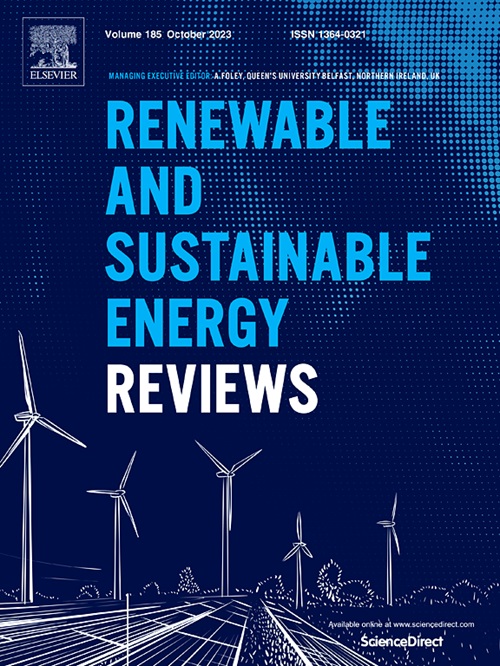Ruminant methane mitigation: microbiological mechanisms and integrated strategies for sustainable livestock production in the context of climate change
IF 16.3
1区 工程技术
Q1 ENERGY & FUELS
引用次数: 0
Abstract
Ruminant methane (CH4) emissions not only cause serious environmental problems but also reduce the energy efficiency of animal feed. Rumen microbial fermentation is a major source of CH4 emissions, and understanding the diversity and community structure of rumen microbes, and the relationship between feed efficiency and CH4 emissions, is key to reducing CH4 emissions. Strategies such as feed modification, microbial regulation and additive application have shown some CH4 mitigation. For example, the addition of fats and fatty acids to the diet composition and the use of probiotics and microbial repellents can change the rumen microbial community structure and improve feed digestibility. Meanwhile, specific chemical analogues and plant secondary metabolites as additives can specifically inhibit the growth of methanogenic archaea and reduce CH4 production. Although multiple CH4 mitigation strategies have been evaluated for reducing CH4 emissions from ruminants, there has been no comprehensive discussion in unravelling the molecular mechanisms of microbial fermentation processes and specific CH4 inhibitors targeting metabolic pathways of methanogens. Therefore, this paper discusses the diversity and community structure of microorganisms in the rumen, methanogenic pathways, and the molecular mechanisms underlying the role of various CH4 mitigation strategies in metabolic reactions and CH4 production pathways in ruminants. This in-depth understanding can help develop more effective CH4 mitigation strategies that can improve the productivity and sustainability of livestock operations while reducing greenhouse gas emissions. The article concludes by outlining important prospects and directions for future research targeting rumen microbial CH4 mitigation and livestock sustainability.
反刍动物的甲烷(CH4)排放不仅会造成严重的环境问题,还会降低动物饲料的能效。瘤胃微生物发酵是 CH4 排放的主要来源,了解瘤胃微生物的多样性和群落结构以及饲料效率与 CH4 排放之间的关系是减少 CH4 排放的关键。饲料改良、微生物调节和添加剂应用等策略在一定程度上缓解了甲烷的排放。例如,在日粮成分中添加脂肪和脂肪酸,使用益生菌和微生物驱避剂,可以改变瘤胃微生物群落结构,提高饲料消化率。同时,作为添加剂的特定化学类似物和植物次生代谢物可以专门抑制产甲烷古细菌的生长,减少甲烷的产生。虽然已经评估了多种减少反刍动物甲烷排放的策略,但在揭示微生物发酵过程的分子机制和针对甲烷菌代谢途径的特定甲烷抑制剂方面,还没有全面的讨论。因此,本文讨论了反刍动物瘤胃中微生物的多样性和群落结构、甲烷生成途径以及各种甲烷减排策略在代谢反应和甲烷生成途径中发挥作用的分子机制。这种深入的了解有助于制定更有效的甲烷减排策略,从而提高畜牧业的生产率和可持续性,同时减少温室气体排放。文章最后概述了未来针对瘤胃微生物甲烷减排和畜牧业可持续性研究的重要前景和方向。
本文章由计算机程序翻译,如有差异,请以英文原文为准。
求助全文
约1分钟内获得全文
求助全文
来源期刊

Renewable and Sustainable Energy Reviews
工程技术-能源与燃料
CiteScore
31.20
自引率
5.70%
发文量
1055
审稿时长
62 days
期刊介绍:
The mission of Renewable and Sustainable Energy Reviews is to disseminate the most compelling and pertinent critical insights in renewable and sustainable energy, fostering collaboration among the research community, private sector, and policy and decision makers. The journal aims to exchange challenges, solutions, innovative concepts, and technologies, contributing to sustainable development, the transition to a low-carbon future, and the attainment of emissions targets outlined by the United Nations Framework Convention on Climate Change.
Renewable and Sustainable Energy Reviews publishes a diverse range of content, including review papers, original research, case studies, and analyses of new technologies, all featuring a substantial review component such as critique, comparison, or analysis. Introducing a distinctive paper type, Expert Insights, the journal presents commissioned mini-reviews authored by field leaders, addressing topics of significant interest. Case studies undergo consideration only if they showcase the work's applicability to other regions or contribute valuable insights to the broader field of renewable and sustainable energy. Notably, a bibliographic or literature review lacking critical analysis is deemed unsuitable for publication.
 求助内容:
求助内容: 应助结果提醒方式:
应助结果提醒方式:


